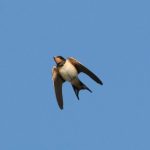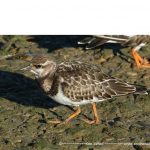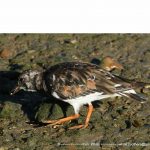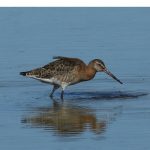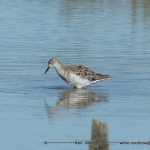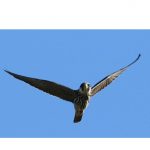Members arriving early in the morning were treated to a Hirundine lift off the reserve reed beds of over 1,000 Swallows, the majority of which were juvenile birds; there were the occasional House Martin and Sand Martin amongst them, but in the early morning sunshine they all had only one thing in mind – they all headed off across the Solent towards the east end of the Isle of Wight, and an hour later they had all gone. Together with the Swallows, a late solitary Sandwich Tern represented the last of the summer migrants on their way south, but a delightful surprise was the newly arrived first family of four wintering Russian Brent Geese flying up the Solent, emphasing the change of the seasons. As the rising tide came in, distant shore birds were pushed up the beach, most of which were Turnstone and Ringed Plover.
After meeting at the reserve visitor centre, the group led by Ken & Sarah White, made their way along to the southernmost hide, a short walk along the coast road and past the sluice, around which the Turnstones posed for close scrutiny allowing the juveniles to picked out. Gadwall were on the beach dabbling in the mud, alongside roosting gulls which included Common Gull and the odd Mediterranean, but the freshwater lakes in front of the Meon Shore Hide afforded close views of Snipe, Black-tailed Godwit, Common Sandpiper and Lapwing. As the day progressed the full sun encouraged us to take to the eastern side of the reserve and so we made our way up to the Knights Bank Hide overlooking the Frying Pan Lake and adjacent meadows. Every effort was made to see the Cattle Egrets that were keeping the reserve cow herd company, but only glimpses were possible due to the tall vegetation in the meadows. En route Water Rail were clearly heard, and Kingfishers dashed up and down the waterways; a patient stalking Heron provided an interesting contrast to the agitated and lively feeding action of a Little Egret viewed from the Suffern Hide. The warm temperatures encouraged noticeable levels of activity from numerous Common Darter and Migrant Hawker dragonflies; this perhaps was the most important factor in the appearance of the day’s star bird later in the afternoon !
After lunch at the visitor centre we called into the Meon Shore Hide again and were rewarded with a different blend of shore birds roosting on the high tide : a small flock of Sanderling adults with juveniles, confiding views of juvenile Black-tailed Godwits, plus one or two Ruff, a wader that always seems to cause confusion! We continued up the west side of the reserve to the Spurgin Hide, from where strips of low growing yellow-flowering plants along the scrape margins were close enough to be finally identified by telescope as the naturalised alien Buttonweed, Cotula coronopifolia , having also been spotted earlier from the Meon Shore Hide. The icing on the cake, however, was a brief but exciting view of a juvenile Hobby gliding in front of the hide devouring one of the unlucky dragonflies, before resuming its normal fast hunting flight straight over the hide and off to the west out of sight behind the trees. While wandering back to the car parking along the beach, a distant group of Common Scoter were found off shore with a couple of Great Crested Grebes. Noisy groups of Oystercatcher on the shore were accompanied by another group of three Brent Geese, a poignant reminder that winter is not far around the corner.
Some members stayed behind for a delightful supper at the nearby Osborne pub, and were treated to an evening-long spectacular sunset.
Report by Ken White
Pictures by Ken White

